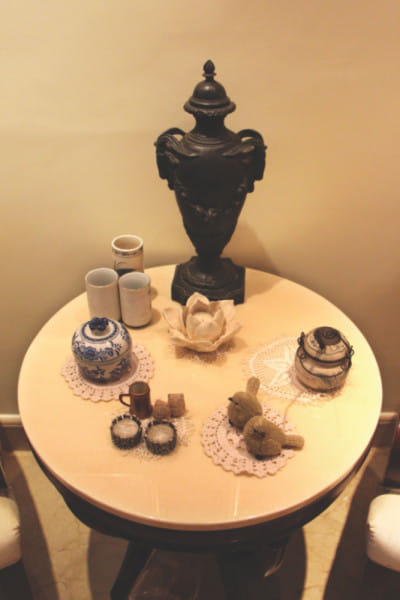Festive furnishings

There are many varieties of accessories for furnishings - things that are extra, useful or decorative but not essential. These are the finishing touches to have some fun with when the paint has dried, the flooring is down and curtains are up.
A room with individuality will often include a mixture of old and new objects or at least things sourced from different places: a set of matching curtains, tablecloths, bedcover, cushions from a chain store, for instance, used next to an unusual lamp from a specialist lighting shop.
Cushions and placemat add comfort and a stylish touch to most rooms. Buttons, frills, lace, crochet and trimming in matching or contrasting fabric add a strong touch to round and square cushion covers.
Lace is a delicate fabric made of yarn or thread in an open web like pattern, made by machine or by hand. At the time of its origin, lace was one of the greatest extravagances. All laces were handmade and extremely expensive. Social status could be determined by the quality and complexity of lace that was worn.
In some regions only people above a certain rank were allowed to wear laces and then only of a certain width, according to their status. Inspectors were positioned at city gates and if someone of a low rank tried to enter the city wearing a lace, which was considered to be too 'good' for them, then their lace was either trimmed down with scissors or burned.
Laces were also used by clergy of the early Catholic Church as part of vestments in religious ceremonies. Earlier in Europe laces had become a very favourite and popular attachment for dresses and household items. It was also a product of an industry that provided a living to thousands of workers and formed a huge portion of the revenue for many nations throughout Europe.
For this special week we will look at how we can revive our traditional lace and crochet pieces for use in our sitting rooms, bedrooms or any corner of the house. In the old days, it was somewhat of a superstition that made our grandmothers cover mirrors with white crochet lace.
Ladies used lace collar blouses, and frilled laces were also very much popular back then. Even in the late sixties, ladies used many lace items for home décor. They used to cover their TV and other precious goods such as musical instruments and favourite Pandabbas with embroidered linen, or crochet lace. However these hand-weaving artistic diligences have been slowly reduced due to massive machine made production of various accessories.
In the last few years, many international brands already have attached crochet lace on their dresses, and the more exclusive ones are handmade. Now machines make many different types of laces, freely available in the markets.
As a designer, I am really fond of laces and I think it is a lovely addition to our home décor ideas. Window dressing is imperative for festivals, and the long drapes of lace create a soothing visual impact. Sometimes half window drapes are lovely, especially with white cutwork triangle patches. There are many unusual varieties of lace available nowadays, as well as the traditional collection of Korean and Chinese nets and laces.
Embroidered bedcovers and linens have been highly appreciated for a long time, along with cutwork, lace and crochet trimmings. White is always gorgeous and soothing for a tropical country like ours. Once four poster beds were very common in Asia, and some Balinese and other Asian resorts still carry these with mosquito netting attached to the posts.
Embroidery and lace trimming on mosquito nets seem really romantic. Bed throws, pillows and cushions are decorative pieces for bed beautification. From a long time designers are attaching lace and crochet trimming surroundings to the pillows and cushions. These can really help to bring out a dreamy ambience in the bedroom.
Something new in the dining area décor is also very sought after during the festivals. White table linen and placemats are unparalleled in class and elegance. Antiques, craftwork and paintings also help to enrich the ambience in our homes. Accessories tell stories of culture and tradition. We can easily place small crochet lace doilies under the antique pieces.
Philippine, Cambodia, Thailand, Korea, Japan and China are still encouraging their traditional handmade lace, appliqué, embroidery and crochet making cottage industries.
I used to collect many varieties of lace from these countries as a hobby; I also acquired some similarly well-known design pattern laces from Europe and Asia. The Lace Museum in Venice, which I was fortunate enough to visit last year, is situated beside the main city courtyard. It is a fascinating display on various types of lace products. Many of the items are now lost, only stored in museums and memories of people like me.
Due to colonial rule as well as the silk route connection, many precious products and artistry were shared between Europe and Asia. Even today our craft shops have many varieties of lace and crochet pieces. I am sure you can find elegant and traditional pieces of crochet work to liven up and enrich your festive home décor, to add a shot of old-world romanticism.
By Nazneen Haque Mimi
Interior Consultant, JOURNEYMAN
E-mail: [email protected]
Photo credit: Tarik Sujat

 For all latest news, follow The Daily Star's Google News channel.
For all latest news, follow The Daily Star's Google News channel. 



Comments